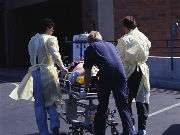Disaster plans must consider children, pediatrics group says

(HealthDay)—Disaster response plans need to place more emphasis on the needs of children, a new American Academy of Pediatrics (AAP) policy statement says.
Events such as natural disasters, terrorist attacks, industrial accidents or disease outbreaks can be especially harmful to children for a number of reasons, the experts pointed out.
For example, children take more breaths per minute, are closer to the ground, and have a large surface area relative to their body mass and more permeable skin than adults, the AAP said in a news release. These factors make children more vulnerable to smoke, debris and other environmental threats.
Exposure to toxic substances poses a long-term threat to young children because they are in a period of critical development. Exposure to radiation and cancer-causing chemicals can damage young children's DNA and increase their lifetime cancer risk, according to the AAP.
Youngsters may not know to run away or avoid dangers, and may even approach them out of curiosity. Also, infants and younger children require appropriately sized medical equipment and doses of medicine, which aren't always readily available.
It's crucial for hospitals to have plans for providing care for children during and after disasters, said statement co-author Dr. Joseph Wright, chair of the department of pediatrics and child health at Howard University College of Medicine in Washington, D.C.
"As a hospital-based provider, I'm particularly intrigued by the fact that in the intervening years since 9/11, a national assessment shows that hospital emergency departments are less likely to have included explicit pediatric elements in their institutional disaster planning than compared to a similar assessment done in the early 2000s," Wright said in the news release.
In 2003, 76 percent of U.S. emergency departments said they included the specific needs of children in disaster planning, but that fell to 47 percent by 2014, Wright said.
Statement co-author Dr. Scott Needle, chief medical officer of the Healthcare Network of Southwest Florida, added that pediatric primary care practices also need to have plans.
"Fewer than half of pediatric offices have preparedness plans. This is particularly concerning because office pediatricians are a key source of health care, including immunizations and mental health care, for families in the community," Needle said in the news release.
Disaster exercises and drills need to include children as both victims and responders, according to the AAP statement. Details of the policy statement were published online Oct. 19 in Pediatrics.
"Disaster response plans are especially important in settings where children are separated from their families, such as schools and child care centers," Dr. David Schonfeld, a member of the AAP Disaster Preparedness Advisory Council, said in the news release.
"Care must be taken that the drills themselves do not inflict psychological trauma on children, however. Staff and students should be informed before an exercise is conducted, especially if it includes scenarios (such as armed assailants) that are sure to be frightening to many children and staff," Schonfeld added.
More information: The U.S. National Library of Medicine has more about disaster preparation and recovery.
Copyright © 2015 HealthDay. All rights reserved.



















